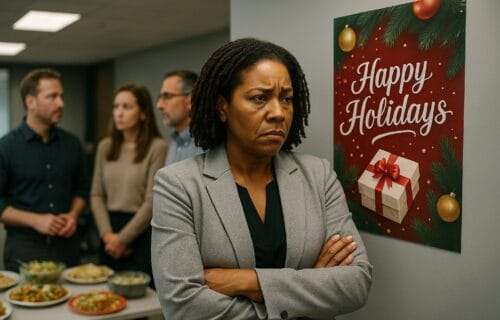
Where Real Healing Happens (And It’s Not Where You Think)
Wow. I can’t believe I wrote about identity death.
Not because it wasn’t true—
but because I didn’t know I was ready to say it that clearly.
It really cracked something open.
And since then?
Healing has been showing up in the weirdest places.
Not in another big tearful release (though yes, sometimes there are tissues involved—mine or a client’s).
But in awkward sidewalk conversations with my husband…
In the moment I stood up for my son against grown-ass bullies…
In laughing at old expectations I didn’t know I still carried.
I think some people assume that because I write about grief, identity, trauma…
that I just float through life crying into a box of tissues, journaling about the void.
Sometimes that’s true.
But more often?
Healing looks like not needing to fix everything.
It looks like letting the mess breathe.
It looks like being okay with my humanity—and other people’s too.
Let’s talk about that kind of healing.
The kind that doesn’t come with closure or applause.
The kind that meets you in the middle of a Costco parking lot, or on a Tuesday walk, or when your kid says, “Thanks for standing up for me.”
What Walking Taught Me About Intimacy and Unspoken Grief
Some of our deepest healing hasn’t happened in therapy or coaching. It’s happened on long, sweaty walks through our neighborhood. Me and my husband, just circling the block—sometimes for an hour or more—talking about everything and nothing.
It’s not that we don’t argue or struggle. We do. But those walks? They’ve become a ritual. A gentle, consistent place where truth can slip out sideways.

I’ll never forget the day we were talking about the crypto crash. I was still mad. Still holding some heat over financial decisions that rattled me. And Hoi just said,
“Just because I don’t talk about it doesn’t mean I wasn’t in pain too.”
That line cracked something open.
We weren’t fighting. But we weren’t fully close either. And in that moment, we got each other.
Then there was me, joking about his brother’s classic guilt-trip line growing up:
“Eat all your food. The farmers sacrificed so much.”
And I couldn’t help myself—
“You think those farmers are crying in the fields because you didn’t eat that last grain of rice? They already got paid!”
We laughed. But also? We healed. Because humor makes room for grief. And grief—when it’s witnessed—is holy ground.
💬 Want more on the cost of silent drift?
In You Built the Business—Now Let’s Talk About Your Marriage, I wrote:
“You didn’t intend to deprioritize love. But somewhere between scaling your business and surviving your stress, you forgot that emotional intimacy isn’t self-sustaining. And the scariest part? It doesn’t break with a bang. It breaks with neglect.”
That’s what our walks repair: the slow drift that happens when presence gets outsourced to productivity.
Where Real Connection Starts (and How to Let It In)
Not everyone has a spouse.
But everyone needs at least one relationship where the truth can walk without fear.
This kind of healing doesn’t require a therapist, a retreat, or a candlelit vulnerability circle.
Sometimes, it starts with a simple moment: a walk, a quiet car ride, folding laundry together, or sitting on the porch saying absolutely nothing.
Here’s how to start building that kind of emotional space—with different people in your life:

💛 With a Romantic Partner (or the one you wish you were closer to):
Don’t wait for a “talk.” Take a walk. Let the conversation meander.
Say: “I’ve been holding a lot—I don’t need a fix, just space.”
Ask: “What’s something you’ve been thinking about, but haven’t said?”
In You’re Not Fighting—But You’re Not Close, I wrote:
“You didn’t mean for this to happen. But if you’re the one finally noticing it—then you’re also the one who can change it.”
It’s not about fixing. It’s about showing up—not as a strategist or manager, but as a witness.
💬 With a Sibling or Family Member:
Initiate something casual: run an errand together, go for coffee.
Ask aloud: “Do you remember when…?”
Say something real—but not raw. Watch how they respond to your softness.
If this dynamic feels fraught, revisit You Didn’t Grow Apart—You Stopped Growing Together:
“Sometimes the drift isn’t because of betrayal. It’s because no one chose to keep growing forward—together.”
Even a shared memory can become a breadcrumb back to safety.
🧠 With a Close Friend or Confidant:
Text them:
“Can we go for a walk or a long drive soon? No agenda—just space to talk like we used to.”
Try:
“What’s something you outgrew that no one knows?”
or
“Is there a part of yourself you’re trying to reclaim lately?”
In Why Platonic Love Might Be the Most Underrated Force in Your Life, I reminded readers:
“Platonic love isn’t lesser. It’s legacy-level. And if you’ve never experienced it yet… it’s not too late to begin.”
This kind of connection doesn’t need fixing. It just needs presence.
🪞 With Yourself (If You’re in a Season of Solitude):
Walk and journal. Let your own voice land.
Ask: “Is there anything I’ve been afraid to admit to myself?”
Or simply practice sitting in silence longer than feels comfortable.
In Intimacy in Recovery, I said:
“Sometimes intimacy begins with you. With letting your heart be seen—even when it’s just you doing the seeing.”
You don’t need to be witnessed by others to become more honest with yourself.
Where Truth Walks Without Fear

Healing doesn’t just happen in brave conversations.
It happens in brave presence—when you choose to show up as you are…
and let someone else do the same.
So take this with you:
Who in your life feels emotionally safe enough for you to try this with?
What kind of space would let you show up as you are—not as you’re performing to be?
And if no one comes to mind—what would it look like to create that safety inside yourself first?
It doesn’t have to start big.
It just has to start honestly.
🟡 If this stirred something open—and you want support rebuilding emotional safety in real time:
👉 Explore working with me – we’ll untangle the patterns that keep closeness just out of reach.
Or revisit this post:
👉 You’re Not Fighting—But You’re Not Close
It’s one of the most honest things I’ve written about emotional distance that pretends to be peace.





